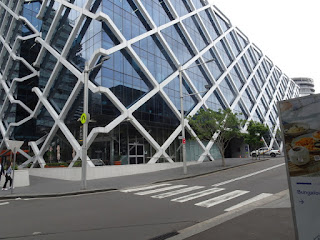Postman's Run on the Hawkesbury River
Last Sunday we joined the Travel Club for a Sunday outing on the Riverboat Postman on the Hawkesbury River. It was a wet day, not the best day for being on the river, but needless to say it was still very enjoyable. The Riverboat Postman is a daily mail service delivering mail and provisions to the isolated water-access-only residents of the lower Hawkesury River. There has been a mail delivery service to these remote residents for over one hundred years, but on Sundays they take a break from delivering the mail and do a sight-seeing cruise in the opposite direction. They cruise past the several islands in the river, past the National Parks and go as far as the entrance into Broken Bay.
We arrived at Brooklyn Wharf by tourist coach in the pouring rain. We left the bus and raising our umbrellas, we queued up to walk through the cutest little boat shed and out on to the gangplank to board our big stable catamaran for the luncheon cruise on the Hawkesbury River. It was warm and dry inside the boat and we sat, in groups, at long tables with a good view of the river through the wrap-around windows. We had morning tea with home-made Anzac biscuits and cups of tea and coffee as we began the cruise past Dangar Island. Lunch was an Aussie Ploughman's-style plate with cold meats and a salad topped with a Turkish bread roll, pickles, chutney, butter and dressing. There was a bar on board and wine and beer and soft drinks were available.
We passed under the Brooklyn rail and road bridges and saw the rusting wreck of Australia's first warship, the HMAS Parramatta lying in the mud flats near Milson Island. We saw sea eagles soaring high in the sky above the sandstone ridges. We cruised in close along the waterline, so we could see several Aboriginal rock carvings. Ken also saw some jellyfish in the water and tried to photograph them.
I was amazed at the size of the River. It is known as "Derrubbin" by the local Dharug, Wannungine, Darkinung, Eora and Kuring-gai indigenous people. This means "wide, deep water". They used the river as a source of food, such as fish, eels, water birds and mussels. Yams, also a staple food, grew along the banks of the river. They travelled on the river in their bark canoes.
In the early days of European settlement, the River was an agricultural highway used to transport food from the farms in the west of the Sydney Basin along its smooth waters, out through Broken Bay into the sea, before heading a few miles south down the coast and into Sydney Harbour to unload at Circular Quay.
The River is now a nature lover's paradise. Much of it is only accessible by boat, with no road access and attracts hermits, holidaymakers, artists, boaters, anglers, oyster farmers and retirees.
I noticed little pockets of housing sitting between mangroves and mountains and these were a mix of ramshackle dwellings of the early European settlers and refurbished retro style bungalows of later Europeans.
I climbed the stairs on our boat up to the deck on top to get a better view and hopefully to take some good photos, but there wasn't much shelter up there and the rain was coming down quite heavily at that stage so I returned to the shelter of the cabin downstairs.
Here is a photo of the cute little boathouse/office at the entrance wharf to the Riverboat Postman.The wreck of HMAS Parramatta. This was a River Class torpedo boat destroyer built for the Royal Australian Navy in the period 1909-16
Here is a little pocket of housing along the river bank.
Mangroves provide habitat for fish and they also protect the foreshore from erosion by retaining the river sediments thus helping to maintain a clean and resilient waterway.
Here is Lion Island which we saw silhoueted against the backdrop of Broken Bay.
A beautiful sandstone cave beside a little sandy beach.
Seagulls resting on a barge in the water.

















